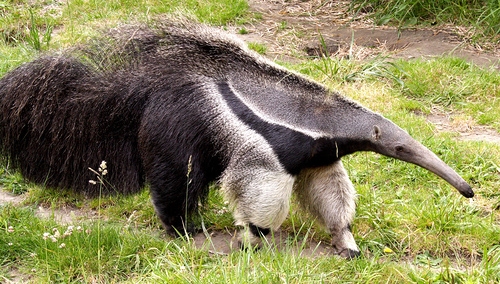
Anteater is the common name for truly toothless mammals of South and Central America that are highly specialized for feeding on ants and termites from their nest hills. The term technically is restricted to four living species of the suborder Vermilingua, namely the pygmy or silky anteater (Cyclopes didactylus) of family Cyclopedidae, the giant anteater (Myrmecophaga tridactyla), and lesser anteaters (Tamandua tetradactyla and T. mexicana) of family Myrmecophagidae. According to the mammalian classification of McKenna and Bell (1997), sloths and the suborder Vermilingua together comprise the order Pilosa, which in turn comes under the superorder Xenarthra (Edenta) with the armadillos.
All four species of anteaters are found exclusively in South and Central America. The giant anteater frequents low swampy savannas, along the banks of rivers, and the depths of the humid forests, but is not abundant anywhere. It lives above ground, not burrowing underground like armadillos or aardvarks or up trees like other anteaters. The species is nocturnal when living near humans, but away from population centers it is active during the day. The giant anteater has no fixed home. Each night, a giant anteater finds a secluded spot and curls up to sleep, with its long bushy tail covering its head and body. The lesser anteaters differ essentially from giant anteaters in their habits, being mainly arboreal and nocturnal. They inhabit the dense primeval forests. The silky anteater is a native of the hottest area in tall humid forests, and is exclusively arboreal and nocturnal in its habits.
Adult anteaters are normally solitary. Though they are generally not aggressive animals, when attacked they can defend themselves with the emission a shrill call (as in silky anteater) or with their saber–like anterior claws (as in giant anteater). An embrace by the giant anteater's powerful forelimbs can sometimes prove fatal. Anteaters feed almost exclusively on ants and termites, although they also take some beetle larvae and bees, and in captivity the giant anteaters accept some fruits (Myers 2001). Their sense of smell rather than any other is used to find prey (McDonald 1997).
The female produces one offspring per birth after a gestation period of around 190 days (for giant anteaters). During much of its first year of life, a young anteater will ride on its mother's back (or tail in the case of the silky anteater), though the baby anteater is capable of a slow gallop four weeks after birth (McDonald 1997). Giant anteaters rarely make sounds. They do it mostly when they are young; the sound is a high-pitched, shrilly grunt noise. A baby that has fallen off his mother's back will grunt to its mother either to remind her that it has fallen off or to simply instruct her where it is or to get her attention (Online Anteater 2001).
SLOTHSloth is the common name for any of the slow-moving, New World arboreal mammals comprising the families Megalonychidae (two-toed sloths) and Bradypodidae (three-toed sloths) of the order Pilosa. There are six extant species. The four living species of Bradypodidae are about the size of a small dog and are characterized by three-clawed digits on their forelimbs and a short tail. The two living species of Megalonychidae are characterized by only two digits on their forefeet, the absence of a tail, and a more prominent snout, and longer fur. Sloths are found in Central and South America.
The living sloths are omnivores. They may eat insects, small lizards, and carrion, but their diet consists mostly of buds, tender shoots, and leaves. The three-toed sloths in particular feed almost exclusively on leaves. The two-toed sloths eat fruits, nuts, berries, bark, and occasionally small rodents.